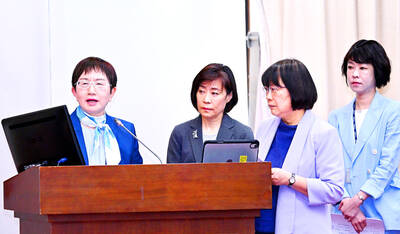Global solar cell module prices are expected to fall to US$1.1 per watt in the next few weeks as weak demand left excessive inventory, which posing a challenge for companies in the industry to eke out profits, market researcher TrendForce Corp (集邦科技) said yesterday.
The indicated decline would be sharper than the US$1.25 per watt the Taipei-based researcher -projected for the first quarter.
The latest quote showed that the price of solar cell modules would decrease 1.64 percent to average US$1.2 per watt this week from the last update on Friday, according to TrendForce’s latest update released yesterday.
“Solar module makers said they have not seen significant signs for a reversal [to recent slowdowns] as demand stagnates and inventory digestion is slow,” TrendForce said in the report.
TrendForce forecast last month that supply for solar capacity would grow to as much as 25 gigawatts this year, exceeding demand of more than 15 gigawatts mostly from Europe.
“Pricing pressure remains [for the near future],” TrendForce said, citing comments from unspecified solar module manufacturers.
TrendForce expected prices to stabilize in the second half of next month as demand could recover.
In addition, TrendForce expected drops in prices for polysilicon and solar wafers, key raw materials for making solar cells, would be mild because of supply constraints this year, meaning moderate price declines in raw material would not offset solar module makers’ price erosion.
Prices of polysilicon and solar wafers are expected to slide 3.98 percent and 1.37 percent to US$69.9 per kilogram and to US$3.6 per unit respectively, TrendForce said.
Shares of Taiwan’s top solar cell maker Motech Industries Inc (茂迪) fell 7.3 percent in the final quarter of last year, even though revenues grew 9 percent to NT$12.8 billion (US$432 million) from NT$1.17 billion in the third quarter.
The benchmark TAIEX gained 8.92 percent in the fourth quarter from the previous quarter.

‘SWASTICAR’: Tesla CEO Elon Musk’s close association with Donald Trump has prompted opponents to brand him a ‘Nazi’ and resulted in a dramatic drop in sales Demonstrators descended on Tesla Inc dealerships across the US, and in Europe and Canada on Saturday to protest company chief Elon Musk, who has amassed extraordinary power as a top adviser to US President Donald Trump. Waving signs with messages such as “Musk is stealing our money” and “Reclaim our country,” the protests largely took place peacefully following fiery episodes of vandalism on Tesla vehicles, dealerships and other facilities in recent weeks that US officials have denounced as terrorism. Hundreds rallied on Saturday outside the Tesla dealership in Manhattan. Some blasted Musk, the world’s richest man, while others demanded the shuttering of his

ADVERSARIES: The new list includes 11 entities in China and one in Taiwan, which is a local branch of Chinese cloud computing firm Inspur Group The US added dozens of entities to a trade blacklist on Tuesday, the US Department of Commerce said, in part to disrupt Beijing’s artificial intelligence (AI) and advanced computing capabilities. The action affects 80 entities from countries including China, the United Arab Emirates and Iran, with the commerce department citing their “activities contrary to US national security and foreign policy.” Those added to the “entity list” are restricted from obtaining US items and technologies without government authorization. “We will not allow adversaries to exploit American technology to bolster their own militaries and threaten American lives,” US Secretary of Commerce Howard Lutnick said. The entities

Minister of Finance Chuang Tsui-yun (莊翠雲) yesterday told lawmakers that she “would not speculate,” but a “response plan” has been prepared in case Taiwan is targeted by US President Donald Trump’s reciprocal tariffs, which are to be announced on Wednesday next week. The Trump administration, including US Secretary of the Treasury Scott Bessent, has said that much of the proposed reciprocal tariffs would focus on the 15 countries that have the highest trade surpluses with the US. Bessent has referred to those countries as the “dirty 15,” but has not named them. Last year, Taiwan’s US$73.9 billion trade surplus with the US

Prices of gasoline and diesel products at domestic gas stations are to fall NT$0.2 and NT$0.1 per liter respectively this week, even though international crude oil prices rose last week, CPC Corp, Taiwan (台灣中油) and Formosa Petrochemical Corp (台塑石化) said yesterday. International crude oil prices continued rising last week, as the US Energy Information Administration reported a larger-than-expected drop in US commercial crude oil inventories, CPC said in a statement. Based on the company’s floating oil price formula, the cost of crude oil rose 2.38 percent last week from a week earlier, it said. News that US President Donald Trump plans a “secondary